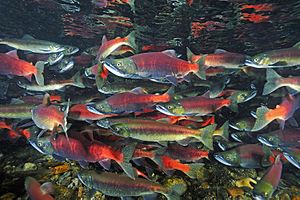Kokanee salmon facts for kids
Quick facts for kids Kokanee salmon |
|
|---|---|
 |
|
| Schooling in a stream near Lake Tahoe, California. | |
| Scientific classification | |
| Genus: |
Oncorhynchus
|
| Species: |
nerka
|
The kokanee salmon (Oncorhynchus nerka) is a special type of fish. It's also known by names like kokanee trout or little redfish. Unlike most salmon, the kokanee lives its entire life in freshwater lakes and rivers. It does not travel to the ocean. Its close relative, the sockeye salmon, does go to the sea.
Scientists are still discussing if the kokanee is a completely separate species from the sockeye salmon. They look at things like where they live, if they breed together, and their genes. Many clues suggest they became different about 15,000 years ago. This happened when melting ice created many new freshwater lakes and rivers in North America. Some salmon went to the ocean, but others stayed in these new freshwater homes.
Contents
Where Kokanee Salmon Live
You can find kokanee salmon in many parts of North America. They live in the northern United States in states like Alaska, Washington, Idaho, California, Oregon, and Utah. They also live in Canada, in British Columbia and the Yukon.
Kokanee salmon are also found in Japan and Russia. People have even introduced them to other places. This includes states like New England, New York, Montana, North Dakota, Wyoming, Colorado, New Mexico, and Nevada. They have also been brought to other parts of Canada.
How Kokanee Salmon Look and Grow
Kokanee salmon are usually smaller than their ocean-going sockeye relatives. This is because there is less food available for them in freshwater. A typical kokanee is about 23–30 centimetres (9–12 in) long. It usually weighs around 0.45 kilograms (1 lb). In places with lots of food, they can grow up to 51 centimetres (20 in) and weigh 1.4–2.3 kilograms (3–5 lb). The biggest kokanee ever caught weighed 2.83 kilograms (6.25 lb).
Kokanee salmon have blue backs and shiny silver sides. Unlike most other salmon and trout, they do not have dark spots on their backs or tail fins. They also have smaller scales, bigger eyes, and a deeply forked tail. Their main food source is tiny water creatures called plankton.
Japanese Kokanee Salmon
There is a special type of kokanee in Japan called the kunimasu salmon, or black kokanee. It used to live in Lakes Akan and Chimikeppu on Hokkaido Island. Sadly, a dam changed the lake's water, and these fish were thought to be extinct by the 1940s. But in 2011, a few were found alive in a hidden lake near Mount Fuji!
The Japanese black kokanee is different from other kokanee. It breeds in March, deep underwater. Most sockeye salmon breed in the fall. The black kokanee is also much darker in color than other kokanee. People have put these fish into different lakes in Japan for commercial fishing.
Kokanee Salmon Life Cycle
The life cycle of a kokanee salmon is much like other salmon. They are born in a stream. Then, they swim down to a lake. They spend most of their adult lives in the lake. Kokanee usually live for about four years in the lake. After that, they swim back to the stream where they were born to lay their eggs. This is called spawning. After spawning, they die. Some kokanee can live for 2 to 7 years.
Kokanee can spawn at different times of the year. This is called a "run." Some groups of kokanee might spawn from August to February. Others have been seen spawning in April. The female kokanee makes a nest in the stream bed. This nest is called a redd. She lays about 1,000 eggs. The number of eggs depends on how much food she had. The eggs hatch in about 110 days. Then, the young fish swim out to the lake.
Appearance During Reproduction
When it's time to spawn, male kokanee salmon change a lot. They turn a bright red color. They also grow a humped back and a long, hooked jaw. Female kokanee also turn a dark red color during this breeding season. These changes help them attract mates.
Protecting Kokanee Salmon
Some kokanee salmon groups are doing well, but others are facing problems. In some areas, their numbers have dropped. For example, in the Snake River in Idaho, they are listed as endangered. In Ozette Lake in Washington State, they are listed as threatened.
One big problem for young kokanee is Lake trout. Lake trout are predators and love to eat young kokanee. In Lake Chelan, Washington, lake trout caused a huge drop in kokanee numbers. Other dangers include pollution, losing their natural homes, and warming water temperatures.
Many groups are working to help kokanee salmon. In King County, Washington, they are trying to save the fish. In 2007-2008, only about 150 fish spawned there. Now, they are working to restore streams and habitats. They also breed kokanee in hatcheries and have banned fishing for them. These efforts have helped increase the number of native kokanee.
In Canada, some lakes have also seen a big drop in kokanee numbers. In Kluane National Park and Reserve, the number of fish dropped from 2,800 to just 88 in 2007. The park has made it illegal to fish for or even have a kokanee salmon. These conservation efforts have been very successful. In 2015, 4,660 kokanee spawned in the park!
Images for kids


